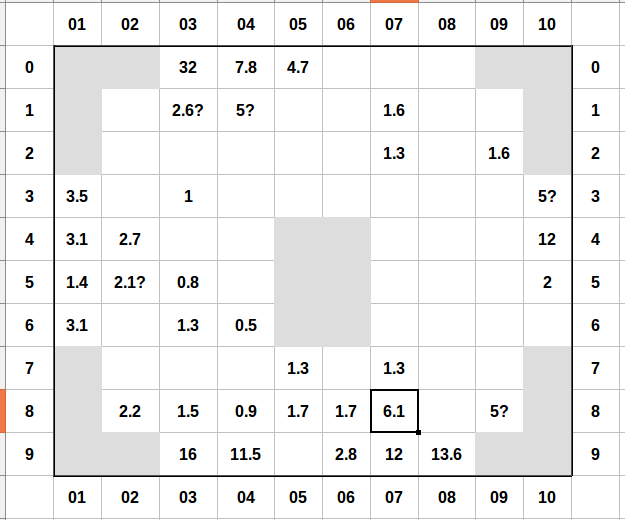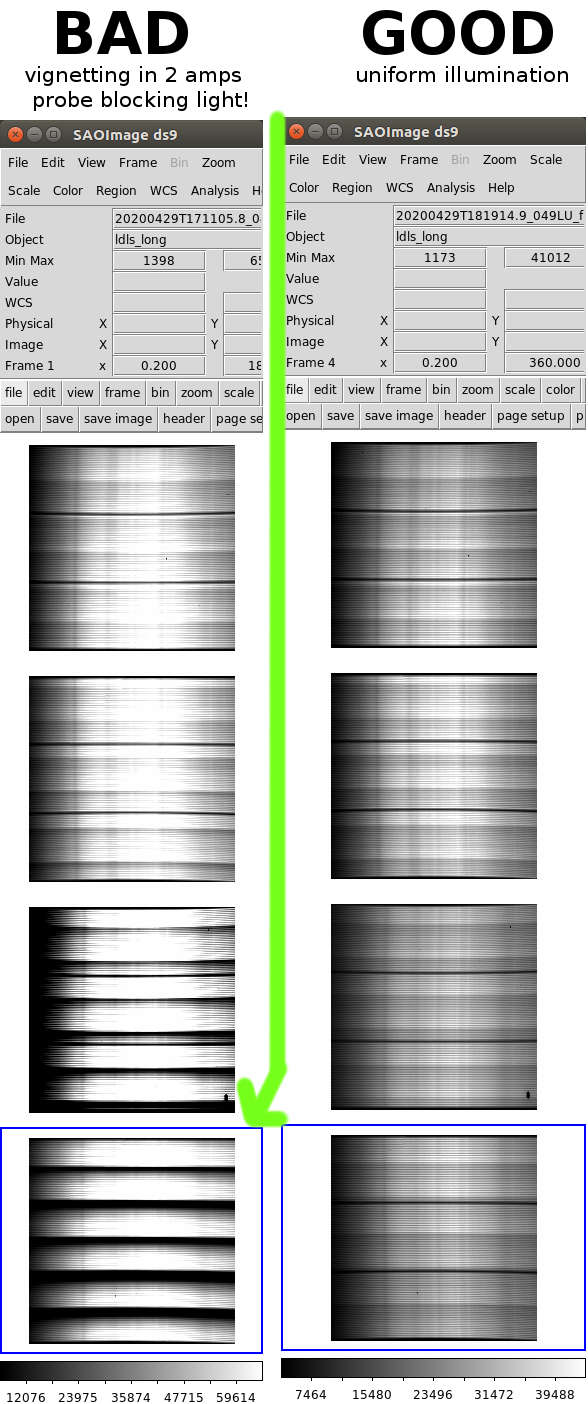VIRUS Defocused Spectral Flat (DSF) Procedure
Note that this procedure can take 15-45 minutes per unit, depending on the exposure times and efficiency of commands used. If you are attempting to acquire DSF data for multiple units, be warned that it may take some time.
Procedures for setting up the UNITS:
Ask day staff to insert the de-focusing spacers.
Results
Note that these numbers are fairly outdated. Logan and Emily are tracking the exposure times now, using the automatic script.
| UT Date | IFU(s) | exptime |
|---|---|---|
| 20200514 | V304/S044 | 3.3s |
| 20200512 | V301/S052 | 4.7s |
| 20200507 | V016/S104 | 12.0s |
| 20200507 | V401/S079 | 12.0s |
| 20200506 | V424/S039 | 16s |
| 20200430 | V422/S078 | 6.1s |
| 20200430 | V423/S089 | 13.6s |
| 20200429 | V420/S030 | 32.0s |
| 20200429 | V425/S049 | 11.5s |
| 20200224 | V417/S068 | 1.7s |
| 20200224 | V016/S104 | 3.7s |
| 20200221 | V416/S058 | ~1.7s |
| 20200221 | V418/S057 | 1.3s |
| 20200219 | V419/S040 | 7.8s |
| 20200219 | V421/S069 | 2.8s |
| 20191203 | V317/S024 | 2.7s |
| 20191203 | V410/S015 | 1.4s |
| 20191203 | V415/S048 | 0.9s |
| 20191125 | V202/S035 | 0.8s |
| 20191125 | V409/S016 | 3.1s |
| 20191111 | V051/S105 | 2.0s |
| 20191111 | V406/S071 | 1.6s |
| 20191024 | V414/S038 | 1.5s |
| 20191024 | V413/S028 | 2.2s |
| 20191024 | V330/S092 | 1.6s |
| 20191018 | V410/S015 | 3.1s |
| 20191018 | V412/S013 | 3.5s |
| 20191010 | V411/S014 | 3.1s |
| 20191010 | V310/S033 | 1.0s |
| 20191010 | V309/S046 | 0.5s |
| 20190826 | V408/S031 | 2.6s? |
| 20190826 | V302/S036 | 1.3s |
| 20190826 | V303/S025 | 2.1s? |
| 20190807 | V402/S077 | 1.3s |
| 20190807 | V403/S074 | 1.3s |
| 20190807 | V405/S072 | 1.8s? |
| 20190722 | V407/S041 | 5s? |
| 20190722 | V402/S077 | 1.3s |
| 20190722 | V027/S098 | 5s? |
| 20190722 | V013/S103 | 5s? |
New script (for day staff to use)
Run "automatic" DSF script: adsf.sh
If run without arguments it does the following:
- asks you which unit(s) which are defocused (up to 4)
- asks you for desired exposure time (based on old exposures, or take good guess)
- turns on cal sign, warms up lamps, turns off IP/VG, etc
- takes LDLS exposure (obsid=6000) at that exposure time
- displays "virusview" of requested unit(s)
- calculates maximum (w/ 5-sigma clipping) for requested unit(s), calculates ideal exposure time(s)
- asks if this exposure time is acceptable; if so runs 30x LDLS exposures (obsid=7000)
- if test exposure was unacceptable, asks for new exposure time, takes LDLS exposure (obsid=6001)
- displays requested unit(s), calculates maximum, estimates exposure times
- asks if new exposure time is acceptable; if so runs 30x LDLS exposures (obsid=7000)
- if new exposure was unacceptable, user has one last chance to input a different exposure time and take 30x LDLS exposures (obsid=7000, no more test exposures)
- turns off cal sign, turns off lamps, turns on IP/VG
- script emails ra@ and day staff with summary and full log - summary can be forwarded to het-dsf@ if all good (log will help troubleshoot/track data too)
Note: If you need to use a different obsid for the test or real data, you can use arguments to the script:
[stevenj@juno ~]$ adsf.sh -h
VIRUS DSF Script for day staff
no arguments needed to run default version,
script will prompt for IFU IDs and exposure time
USAGE: adsf.sh [-debug] [-testid 6001] [-realid 7001]
-testid Test exposure id (default 6000)
-realid Real exposure id (default 7000)
-cleanup clean up after script failure
-debug testing and dry run
Old script (not certain of its status)
Run ~sir/dev/astro/operations/virus_tests.sh <vac|dsf> [-skipip]
"skipip" only if you do not need that script deal with IP and VG.
Script first warm up lamps and entering test mode to determine correct exposure time. It will ask for max flux level after each test exposure and will display corrected exposure time. Available commands are:
next go to next IFU cals finish testing and run/print cals block quit exit the script
Manual procedures for taking the data
Note we are trying to use the same numbering for engineering tests so for the test exposures please use the 6000s and the final DSF exposures please use 7000-7099. Test exposures can be taken in the 6xxx range.
Here is a brief summary of what we do to take the data: (see note below about taking data for multiple units at the same time)
- ipvg off -V # Turn off the IP and VG
- Optional: manually turn on the LDLS, if you want to skip warmup times for each exposure.
- cal virus -l ldls_long -L 1 -o 6000 -bexp 1.3 -B # take a single exposure with twice the exposure time to test exposure length
- optional: if you have already warmed up the LDLS, use old notation with vlcal: vlcal -i virus -l ldls_long -L 1 -o 6000 -bexp 1.3 -skip_warmup -B
- cd /hetdata/data/YYYYMMDD/virus0006000/exp01/virus/ # where YYYYMMDD is the current UT date (note takes 1-2 minutes for all files to arrive)
- virusview ### # look at the unit you need (S###) - it should be about 47-53k counts.
- cal virus -l ldls_long -L 1 -o 6001 -bexp X.X -B # where X.X is the new exposure time based on the previous exposures
- optional: again, you can use the vlcal no-warmup option for more efficient results: vlcal -i virus -l ldls_long -L 1 -o 6001 -bexp X.X -skip_warmup -B
- cd ../../../virus0006001/exp01/virus/ # change directory to where the new data is (note takes 1-2 minutes for all files to arrive)
- virusview ### # look to be sure that the relevant unit (S###) has the correct level at ~47-53k.
- cal virus -l ldls_long -L 30 -o 7000 -bexp Y.Y # where Y.Y is the final exposure time based on the previous exposure
- optional: no-warmup version: vlcal -i virus -l ldls_long -L 30 -o 7000 -bexp Y.Y -skip_warmup -B
- ipvg on -V and turn off LDLS it is still on.
- Email: het-dsf@het.as.utexas.edu with information about the DSF data.
- The email subject line should be: DSF data set taken for Sxxx-Vyyy [, Szzz-Vaaa, etc]
- The email body should include:
- the YYYYMMDD of the data directory
- the observation number for the final data
Below are two examples of DSF data:
- Left: example where a probe is blocking some of the fibers on the unit (solution: move probe)
- Right: example of nominal/good data
NOTE If DSF data are required for multiple units at the same time, Karl prefers a single set of exposures. First, determine the required exposure time for all relevant units. For example, say there are two units defocused, one which requires 2.4s and the other at 0.9s (to reach 47-53k on each). Find the dynamic range of the exposure times (in this example, 2.4 / 0.9 = 2.67) and multiply the nominal 30-exposure sequence by about 2/3 of that factor (in this example, 30*2.67*(2/3) = 53 exposures).
Attachments (2)
- DSF_example.jpg (111.9 KB) - added by stevenj 4 years ago.
- DSF_exptime.png (27.4 KB) - added by stevenj 4 years ago.
Download all attachments as: .zip


